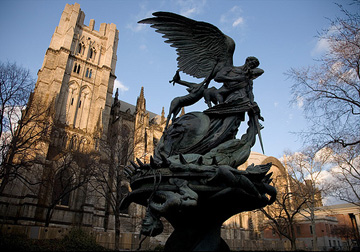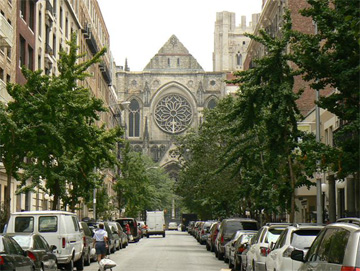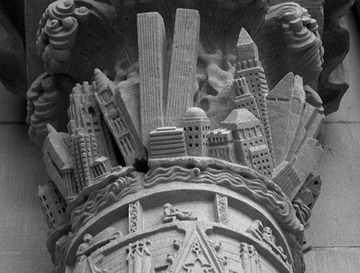Rev. Tom Miller is the Canon for Liturgy and the Arts at New York’s Cathedral of St. John the Divine, affectionately known as “New York’s Cathedral,” even though it is affiliated with the Episcopal Church.
As the largest Gothic cathedral in the world, St. John the Divine is a unique structure with a a one-of-a-kind mission to embrace the whole city. It is a grand structure which fully reopened last November, after a fire damaged the building in 2001. It has a majestic presence in the Morningside Heights neighborhood of Manhattan and since the early 1970s, it has fostered a strong and lasting relationship with the world’s performing and visual arts.
In the last few years alone, the Cathedral has hosted major exhibitions, including A Time For Hope, which showcased the arts of the autonomous region of Castille-Leon in northern Spain, and the Season South Africa show in 2004, which featured the work of 17 South African artists and was co-hosted by the Museum of African Art.
Rev. Miller is a thoughtful man whose urbane sensibility serves him well in New York. He explains that the Cathedral’s openness to contemporary art is multi-faceted, and he elucidates this point with some thoughts on Episcopalian theology and his personal views on the role of art in society.
When one work in the Season South Africa exhibit sparked controversy from school groups and Catholic organizations because of its contemporary take on the Pietà, he took it in stride and mentioned that it reminded him of a hymn which spoke about Christ making the unlovely, lovely. “No one is excluded,” he said. “Artists help us ask the difficult questions we shy away from.”
“In the Episcopal tradition, incarnation is an important part of the doctrine, but it’s not just in doctrine, devotion, or liturgy. So, it is part of tradition to think that everyone in the world, not just church people, are created with this creative impulse. Artists live to investigate and understand the world and sometimes advocate,” he says.
Rev. Miller works closely with Lisa Schubert, Vice President for Events, Marketing, and Communications at the Cathedral, and together they work to integrate visual arts into the Cathedral’s programming.
The following interview was conducted via email.

St. John the Divine's Peace Fountain with the Cathedral in the background. Photo by Alexander Kagan via Flickr.
Hrag Vartanian: Can you tell me about St John the Divine’s visual arts programming?
Rev. Tom Miller: Our visual arts programming invites both established as well as developing artists to install work that reflects on the human condition and those qualities of heart, mind, and soul that respond to a greater awareness of the sacred nature of human life (often in relationship to the divine, defined as broadly as possible).
HV: How does it fit into the mission of St. John?
TM: As New York’s Cathedral, we claim to be a House of Prayer (broadly defined) for All People, which means we have a profile beyond our denominational identity or doctrinal focus. Our mission is to serve the enlightenment of all people in ways of justice and peace, and in that regard, to encourage respect for the dignity of all human beings. Art helps us to do that, but we must necessarily move beyond “church art” and find other expressions of the many ways this divine purpose is perceived by many people. From a scriptural stand point, we claim the belief that God truly did and does come into the world so that we might have life and have it more abundantly. The late Archbishop of Canterbury, Michael Ramsey, among others, was fond of quoting Irenaeus: “The glory of God is a human life fully lived.” That’s my starting point.
A life fully lived necessarily has to do with art, since we are all disposed to it, and it serves us individually and collectively as an integrating agent that connects our hearts and minds and makes us more than we can know or be otherwise. This has something to do with the imagination, of course, and it has something to do with compassion.
HV: What role does the concept of “compassion” have within that mission?
TM: Compassion involves awareness (or consciousness), enquiry, and empathy (or compassion). For us, compassion finds a powerful exemplar in Jesus, who seemed always to be aware, or to be striving to know the reality of peoples’ lives and his own identity, for that matter. He then inquired about what people needed, what was lacking in their lives, when it wasn’t already apparent. And finally, he undertakes his own “passion” and makes it “compassion” by offering his passion for the good of the world and the illumination of human beings then and down through history.
Now, you can take the Jesus bits out and I think my original statement is true and it informs our criteria for art in the Cathedral. Does the work raise our consciousness about the (or a specific) human condition? (And condition can sometimes be simply the beautiful and sublime.) Does it assist us to contemplate the reality of the human condition (or conditions)? And in a way we frequently cannot control, does the awareness and contemplation lead us to the deeper and more profound place of our integrated being in order to offer ourselves to make a difference or at least to be in solidarity with the human reality of the condition?
The formulation the Cathedral often uses is to say we are a place where liturgy and the arts lead us to discourse and on to advocacy. Again, because art can move us beyond the narrow world of dogma and church tradition, it is an invaluable part of our mission. Art can help us go where our set ways might keep us timid.
HV: Who are some of the artists that have participated in the art programming at the Cathedral?
TM: We’ve had any number of artists. In the past, Bill Viola did a piece here. We’ve worked with Jenny Holzer (Season 4), Michel Ostlund, Pat Lipsky, Thomas Albrecht, Barry Moser, Frederick Franck, Gregg Wyatt, a lot of others.
HV: Why do you feel it is crucial to continue St. John’s inclusion of visual art within its programming?
TM: To some extent, I think the answers above at least begin to answer your question here. The Cathedral is blessed with fantastic permanent “sacred art.” There, glass, stone, wood, and the architecture itself are glorious, but art and the imagination are alive, and although the sacred arts elicit a lively response from most people, we would be missing a huge asset by not making art in the Cathedral, through contemporary artists, through artists-in-residence, and by keeping the awareness, enquiry and empathy (or compassion) part of our life.






Pingback: Art & Compassion at New York’s Cathedral of St John the Divine — Hrag Vartanian
Pingback: What’s Cookin at the Art21 Blog: A Weekly Index | Art21 Blog